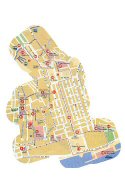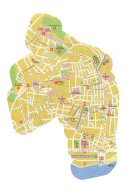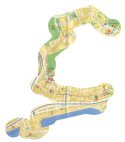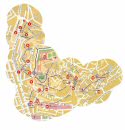|



 |
|
Start by taking the Santa Justa Elevator (1) up to the ruins of the Carmo
Convent (2), destroyed in the 1755 earthquake. This is the only remaining
example of early gothic architecture in Lisbon.
Walk up Rua da Trindade, where you can see the impressive façade of the
Trindade Theatre (3), then continue down the road to visit the two
churches, Igreja do Loreto (4) and Igreja da Encarnação (5).
Go down Rua Garrett to the church called Igreja dos Mártires (6) , then
go by Lisbon’s opera house, the São Carlos Theatre (7), and visit the Chiado
Museum (8), in Rua Serpa Pinto.
Go down the winding Calçada do Ferragial that takes you to the 17th cent.
Corpo Santo Church (9) then turn left onto Rua do Arsenal, leading to Praça do
Município (10), and the Lisbon Town Hall, built in 1774 and subsequently
undergoing major modifications.
Two blocks east lies one of Europe’s outstanding city squares, the 18th
cent. Praça do Comércio (11). From the SE corner of the square, in front
of the ferry terminal (12), where you can take a river tour, go east to the
Campo das Cebolas, where the odd Casa dos Bicos (13) stands.
Now go back along Rua da Alfândega, where you’ll find the ornate Manueline
façade of the church of Nossa Senhora da Conceição (14). Stop off for
lunch, or a ‘bica’, a little cup of aromatic black coffee, in the 200 year old
Café Martinho d’Arcada, a favourite hang out of the poet Fernando Pessoa, then
pass under the great neo-classical archway called Arco da Vitória (15), where
the pedestrian mall, Rua Augusta (16) begins, and take in the cosmopolitan buzz
of one of Lisbon’s main shopping hubs.
At the top is Praça D. Pedro IV, the square known to Lisboners as Rossio.
Turn right off the NE corner of the square to the church of S. Domingos (17),
founded in 1241, and reconstructed after the 1755 earthquake. Turn back to where
Portugal’s National Theatre, the neo-classical Teatro Nacional D. Maria II (18),
built 1842, stands at the north end of Rossio. From here, Rua das Portas de
Santo Antão takes you to the Palácio da Independência (19) and Praça dos
Restauradores (20).
On the opposite side of this square are the Palácio Foz (21), the
neo-Manueline Rossio railway station, and the Glória Funicular (22), which takes
you up to the Bairro Alto, with its narrow streets and bohemian nightlife.
As an alternative to the funicular, go back down through Rossio (23) and walk up
Rua do Carmo and Rua Garrett, the streets that make up the earth of Chiado. An
old quarter dear to Lisboners, the Chiado (24) suffered a serious fire in 1988
and has now been reconstructed following a master plan drawn up by leading
Portuguese architect, Álvaro Siza Vieira.
|




|
|
At the top of the Glória Funicular (1) are the gardens and belvedere of S.
Pedro de Alcântara (2). Continue past them along Rua D. Pedro V until you
come to the Príncipe Real Gardens (3), under which there is a water cistern,
built in 1864 that can be visited on weekdays. Farther down the road are the
museums of Natural History and Science (4) and the Botanical Gardens (5).
The streets Miguel Pais and Monte do Carmo will take you to Rua Cecílio de
Sousa, from which a flight of stairs (6), will take you back up to the Príncipe
Real Gardens.
Cross the gardens and go down Rua do Século, turning right at the bottom into
Rua da Academia das Ciências, where the Portuguese Academy of Science and
Geological Museum are located (7). Now take Rua de S. Marçal up to the romantic
little square called Praça das Flores (8), where some excellent restaurants are
located.
Go down Rua de S. Bento, where there are a number of antique shops, and, on
the left hand side, Espaço por Timor (9), the center created to support
the rights of the people of Timor to independence and their courageous
resistance to the Indonesian occupation.
At the end of the street on the right is the São Bento Palace where the
Portuguese Parliament sits (10). Continue in the same direction down Av. D.
Carlos I to the fountain called the Chafariz Monumental da Esperança (11), by
the architect Carlos Mardel, then take Rua do Poço dos Negros and Calçada do
Combro up to the Church of Santa Catarina (12) and the magnificent
belvedere of the same name (13).
Ride the Bica funicular (14) down to Rua de S. Paulo, and to the square,
Largo de São Paulo (15), built in 1849, with its church and fountain (16).
In Travessa do Carvalho are the old baths known as the Banhos de São Paulo
and farther ahead, going west through Praça D. Luis I (17), is the municipal
market known as the Mercado Municipal de 24 de Julho (18), built in 1876.
There is an important public transport interface with bus, metro, tram and
ferry lines at Cais do Sodré (19) railway station, where the Cascais train line
begins. Try some charcoal-grilled fish along the attractive Passeio Ribeirinho
(riverside walk) (20), then climb Rua do Alecrim to Luis de Camões Square (21)
and the Church of S. Roque (22).
Go into the Bairro Alto quarter (23) and sample its renowned nightlife. You
can hear genuine Fado and pass some enjoyable hours without any worry about
personal safety.
|




|
|
Begin your walk at the Estrela Gardens (Jardim da Estrela) (1) with their
wrought iron bandstand.
Busses: 9, 27;
Trams: 25, 28.
Facing the gardens is the Estrela Basilica (Basílica da Estrela) (2), in late
baroque and neo-classical style. The four columns on the façade are topped with
statues representing Faith, Devotion, Gratitude and Generosity. The relief
behind is thought to be the work of Portugal’s foremost 18th cent. sculptor,
Machado de Castro.
Take the streets Domingos Sequeira and Saraiva de Carvalho to the square
Praça São João Bosco and the Prazeres Cemetery (Cemitério dos Prazeres)
(3) and then, taking Rua Possidónio da Silva, go on to Tapada das
Necessidades (4) to see its excellent cactus gardens. Nearby is the Necessidades
Palace (5), built in the 18th cent. and now the home to the Ministry of Foreign
Affairs.
From the square in front (6) you can pick out the 25 of April bridge,
inaugurated 1966, and the Christ the King monument on the other side of the
river. Note the bronze cross on a thorned sphere in the 1747 fountain, and an
obelisk in pink marble.
Now go down Calçada do Sacramento leading to the Alcântara quarter (7) and
Praça da Armada (8), where there are a number of good, low-priced restaurants
and taverns. Continue your walk along Calçada da Pampulha to Rua das Janelas
Verdes: on one side is the Dr. José Figueiredo square (9) with its great
fountain, and on the other the National Museum of Art (10).
From the gardens (Jardim 9 de Abril) (11) beside it there are views
over the river and the Port of Lisbon. Overlooking the gardens is the Red Cross
Palace, the stairs leading of the gardens will take you down to Av. 24 de Julho.
Cross the avenue and the railway line alongside it then turn right on
Av. Brasília and follow it to the Alcântara Dock (12) where you’ll find the
Maritime Terminal (13) with its great mural panels by the Portuguese modernist
painter Almada Negreiros.
Walk through the bustling, cosmopolitan Santo Amaro Dock (14), packed with
riverside café terraces, bars and discos.
Busses 14, 32, 43, 28 will take you back to the center.
|




|
|
This walk begins at the Martim Moniz Metro station in Rua do Capelão (1) and
continues along Rua da Mouraria to the Church of Senhora da Saúde (2), with its
beautiful tiles and carved wood altar. The church is open for visits on
afternoons or whenever there is a mass. In the recently reconstructed Martim
Moniz square is the singularly multi-racial shopping center called Centro
Comercial da Mouraria.
Enter the picturesque Mouraria quarter by the steps called Escadinhas da
Saúde (4) and go on to Largo da Rosa, where there is a convent of the same name
(5), and the Church of S. Lourenço.
Now go on to Largo da Achada (6) and the Church of S. Cristóvão (7). Then
take Calçada Marquês de Tancos, and you´ll come to the municipal market
called Mercado Municipal do Chão de Loureiro (8), with its painters’ studios and
splendid terrace.
Take Rua da Costa do Castelo past the Chapitô circus school (9) then take the
S. Crispim stairs (10), down to Rua de São Mamede, with the Correio Velho
Palace (11) on the left. Take Travessa do Almada to the Church of Santa Maria
Madalena (12). From there, Rua da Sé takes you to Largo de Santo António (13)
with its taverns and the St. Anthony Museum. A little farther up is the
Cathedral (14), built in 1147, where you can visit the church, the treasury and
the Roman ruins.
Take Rua Augusto Rosa up to the Santa Luzia belvedere (15) and enjoy the
panoramic views of the Tagus and the Alfama.
But there is still St. George’s Castle (16) to be seen - Centro de
Interpretação da Cidade. You can reach it with the aid of the map via Rua de S.
Tiago. It is worth the climb. The finest views of the city and the river can be
had from its gardens and parapets.
When you leave, turn left onto Rua do Chão da Feira, to get to Largo
Mor and the Church of Santa Luzia (17). Largo das Portas do Sol (18) with its
popular café terraces is an ideal place to take a rest and admire the views. If
you feel like continuing, take the stairs on the right down to Largo de S.
Miguel, then take the narrow Beco do Carneiro to the Church of Santo Estevão
(19). Rua dos Remédios will take you to Largo do Chafariz de Dentro (20) - Casa
do Fado e da Guitarra Portuguesa.
If it happens to be June, when the Festas Populares take place, you’ll find
the narrow streets and alleys festooned with lamps and decorations and packed
with revellers.
|




|
|
This western suburb has an enormous number of prime tourist sights and
cultural attractions.
Bus: 14, 27, 29, 43, 49, 51.
Tram: 15.
Train: Belém station on the Cais do Sodré – Cascais line.
Begin at the Belém Palace (Palácio de Belém) (1), official residence of the
President of the Republic, and try one of the renowned Belém pastries in the
traditional pastry shop on the corner (2).
Walk up Calçada do Galvão to the Tropical Agricultural Garden-Museum
(Jardim-Museu Agrícola Tropical) (3) and then go back down to the Jeronimos
Monastery (Mosteiro dos Jerónimos) (4) and to the Archaeological Museum
(Museu de Arqueologia) (5). Visit the Gulbenkian Planetarium (Planetário
Gulbenkian) (6) and the Naval Museum (Museu de Marinha) (7).
Take a look in the spectacular Belém Cultural Center (Centro Cultural de
Belém) (8), designed by Italian architect Vittorio Gregotti and Portuguese
architect Manuel Salgado, and have lunch looking out over the Tagus and the
Belém gardens (9).
Cross over to the riverfront using the pedestrian underpass and visit the
Discoveries Monument (Padrão dos Descobrimentos) (10). Take the elevator up to
the top, enjoy the panoramic views, and don’t miss the bird’s-eye view of the
great Compass Rose (Rosa dos Ventos) on the pavement below.
Next walk west along the riverfront to the Museum of Folk Art (Museu de Arte
Popular) (11). Continuing in the same direction, walk by the Bom Sucesso dock
(Doca do Bom Sucesso) (12) until you come to the famous Belém Tower (Torre de
Belém) (13).
After visiting it, continue past the Bom Sucesso fort (Forte do Bom Sucesso)
(14) next door and use the pedestrian bridge to cross the train tracks and
highway to Av. Torre de Belém (15), walk up it to Rua de Pedrouços where you can
catch a number 15 tram to Praça Afonso de Albuquerque (16) and the Belem River
Ferry Station (Estação Fluvial de Belém) (17). A short walk east is the
Electricity Museum (Museu da Electricidade) (18).
After a visit here, relax on one of the river front terraces.
Busses for the center: 14, 28, 43, 49, 51.
|

